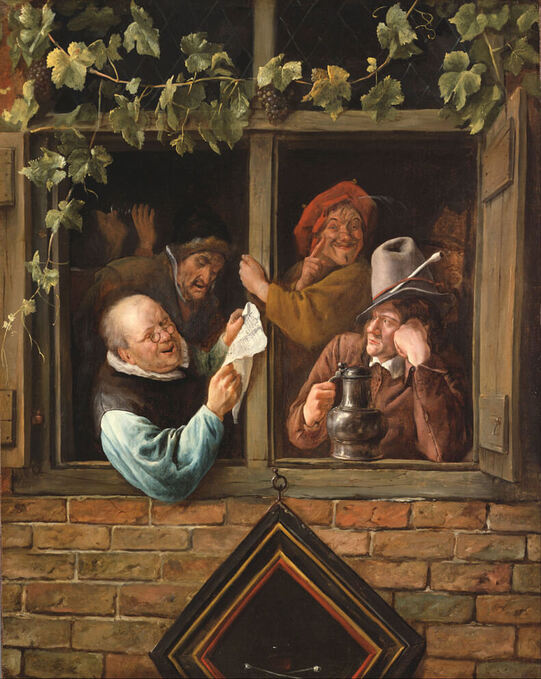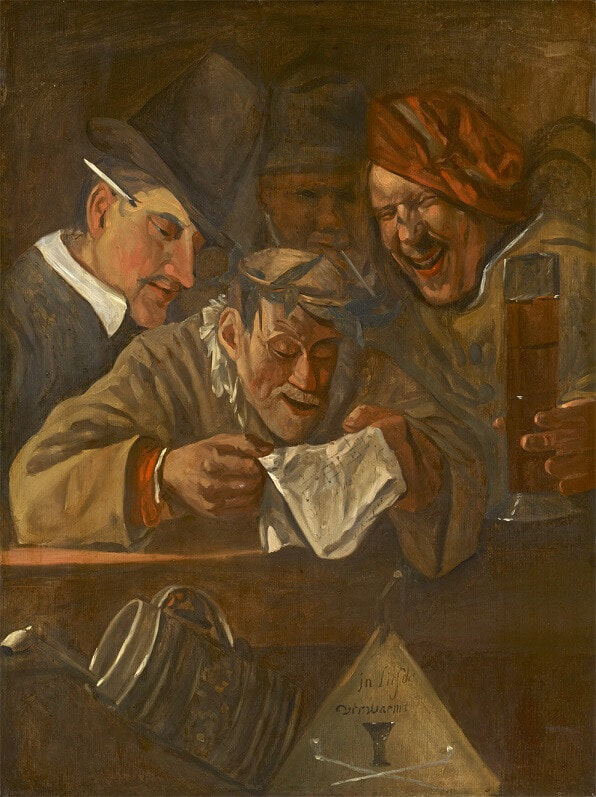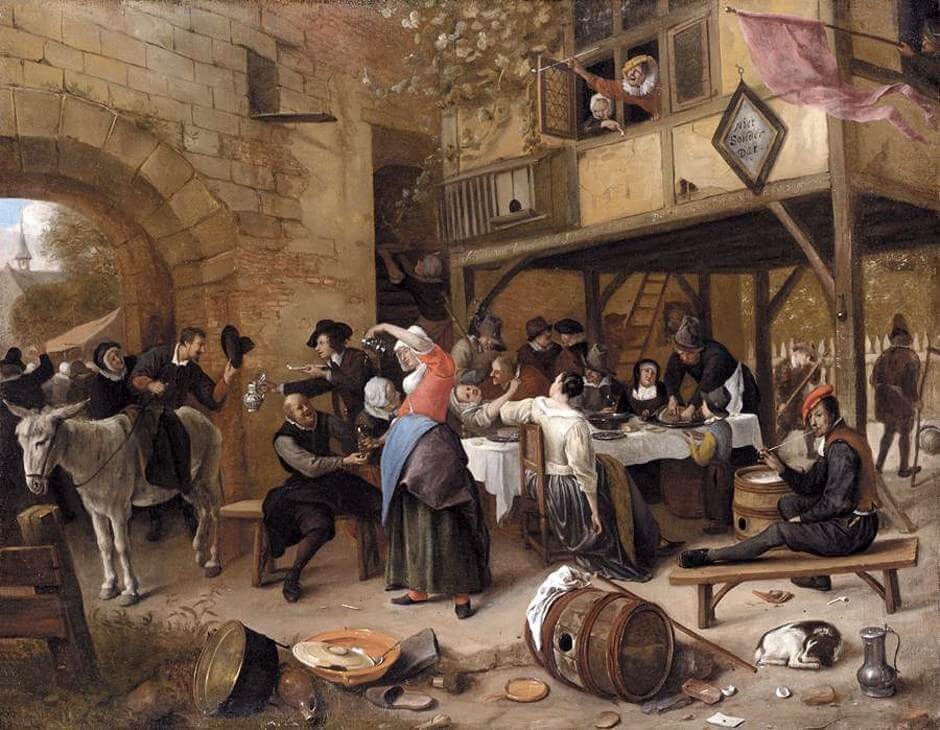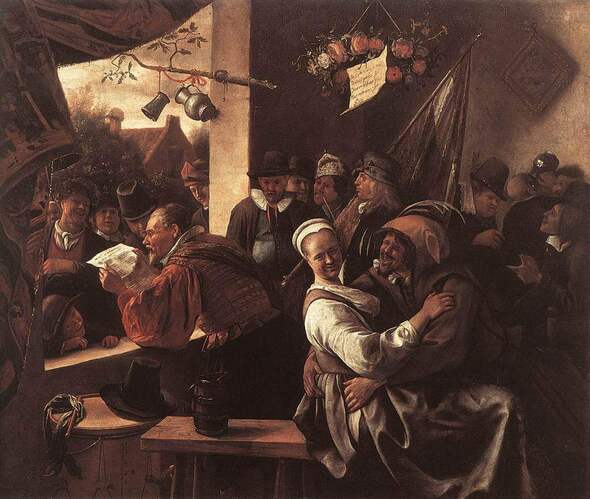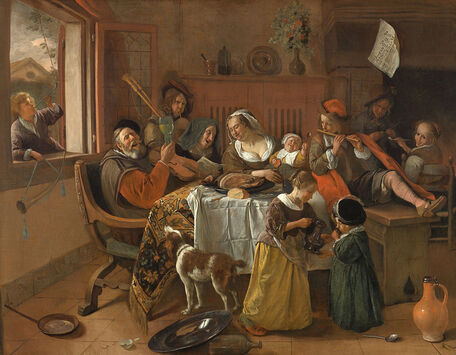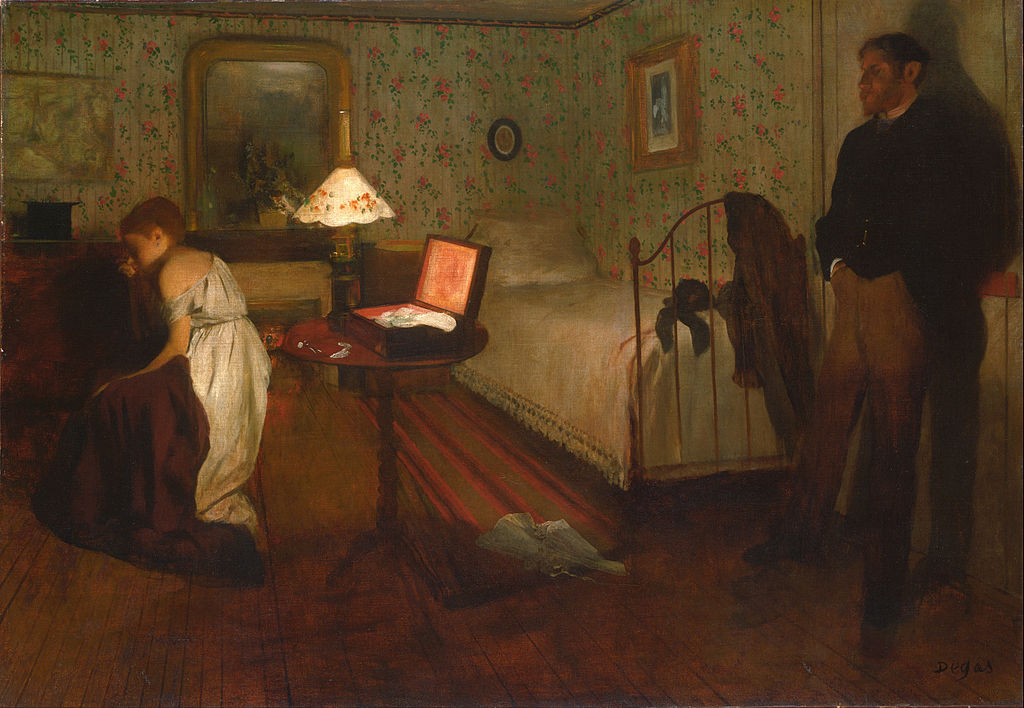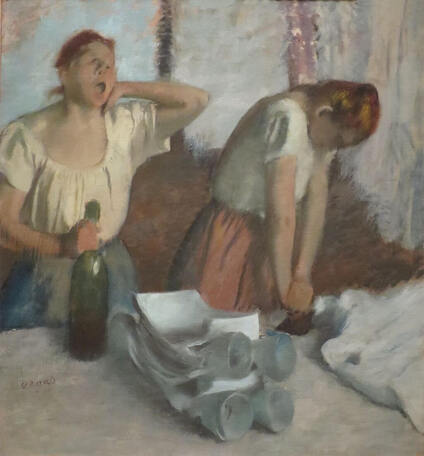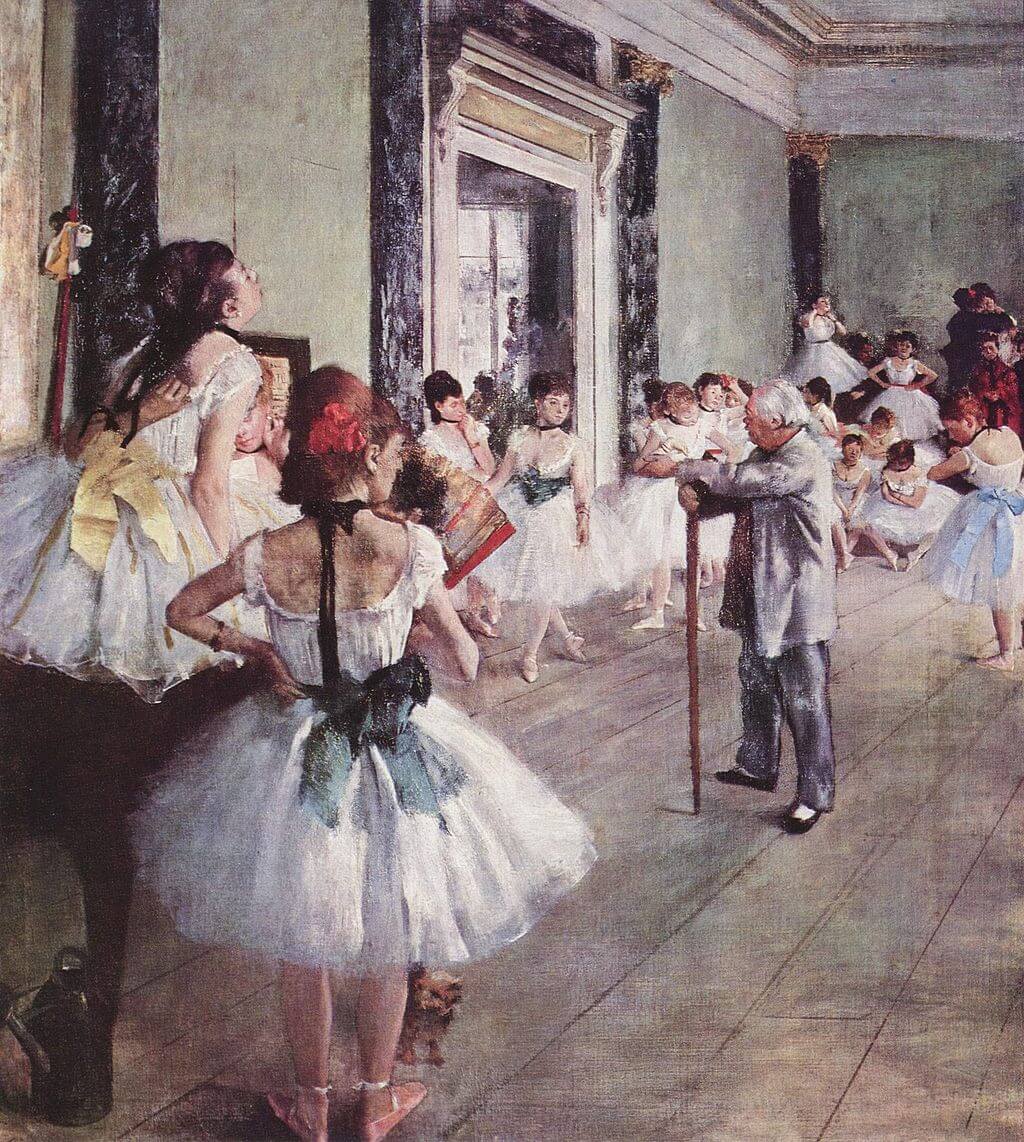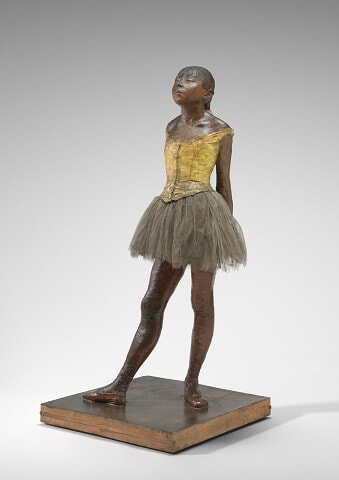|
Where? Gallery 264 of the Philadelphia Museum of Art
When? 1658-1665 What do you see? A window with at least five men who seem to be enjoying themselves (it seems that there is a sixth man on the top right, but he is not clearly visible). These men are members of the chamber of rhetoric, which is a society of amateur poets and performers, and these societies existed in Belgium and The Netherlands since the 15th century. On the left, a man is enthusiastically singing from a paper entitled ‘lof liet’, which is Dutch for ‘song of praise’. The person standing behind him has created this song. Behind them stands a man who is drinking. The person sitting in the right window is critically listening to the song. He is firmly holding a jug that probably contains wine. He is wearing a hat with a pipe attached to it. Behind him is a so-called jester wearing a red cap. He is entertaining the crowd (which you cannot see, but who are also listening to this performance) and puts up his finger to capture their attention. On top of the window grows a vine with ripe grapes. Below the window hangs the emblem of this chamber of rhetoricians, which includes a glass of wine and two crossed pipes. Backstory: Jan Steen painted the rhetoricians more often during his career. In this painting, it is unclear whether Steen wanted to show his appreciation for the rhetoricians or whether he is somewhat sarcastic in the way he depicts them due to the many references to drinking. Steen created several other paintings featuring the rhetoricians. The painting Rhetoricians of Steen is currently in Museum Bredius in The Hague. The Feast of the Chamber of Rhetoricians near a Town-Gate is in a private collection. The Rhetoricians - In Liefde Vrij is in the Royal Museums of Fine Arts of Belgium in Brussels.
Symbolism: The people in this painting show different emotions. Some believe that this painting expresses the four temperaments:
Chamber of rhetoricians: This society was a popular one in Belgium and The Netherlands since the 15th century. They existed both in large cities and small towns and focused on poetry and drama. They were often depicted, by artists like Jan Steen, as people that primarily liked to drink large quantities of wine. However, in reality, these societies were a little bit more serious and also provided cultural experiences for the common people by organizing plays and poetry contests. Their performances focused on providing morals to the people and stimulating the audience intellectually. However, as indicated by the emblem in this painting, the chamber was also a social place where members drank wine and engaged in discussions. Who is Steen? Jan Havickszoon Steen was born in Leiden, The Netherlands, in 1626, and also died there in 1679. He lived at the same time as Rembrandt. Steen came from a family of brewers, which may explain the abundance of alcohol in some of his paintings (which also includes alcohol consumption by children, like in his painting The Merry Family in the Rijksmuseum). He is also known to drink quite a bit himself. Steen is considered a genre painter as he often depicted scenes from everyday life. However, he has also created some paintings with biblical, mythological, and historical themes. He often incorporated some humor in his paintings, is known for his colorful paintings, and his contemporaries appreciated his works. Steen created many paintings during his life, and over 300 of them have survived.
Fun fact: In the 17th century, people consumed a lot of alcohol as the water quality was poor and alcoholic beverages were much safer to drink. Alcohol was even served in both the Catholic and Protestant church. Drinking was an important part of the many guilds and societies in the Dutch Republic during this time. Festivals were organized by all the guilds and societies, and usually, the emphasis of these festivals was on excessive drinking and eating.
It seems that the members of the chamber of rhetoricians drank more than average and drinking was an important part of their meetings. Drinking was also one of the more common themes of their poems and plays, and when they performed for an audience, drinks were always nearby.
0 Comments
Where? Gallery 153 of the Philadelphia Museum of Art
When? 1868-1869 What do you see? Two people are shown in a bedroom. On the right is a man standing against the door with his legs wide and his hands in his pocket. He is standing in the darker part of the room, and you can see his large shadow on the door. On the left, is a woman kneeling down. She is partially undressed, and the lamp behind her lights her white dress. The woman is facing away from the man, and she may be crying. Behind the woman is a round table with a lamp on it and a sewing box with a piece of clothing inside. On the floor lays a white corset. The single bed is neatly made up with the woman’s hat and a cloak at the foot end. The wall is decorated with wallpaper with pink flowers on it. In the background is a fireplace and above it hangs a mirror. On the left, you can see the top hat of the man on top of a closet. Above the top hat hangs a map on the wall.
Backstory: After painting this work, the painting remained in the studio of Degas for 36 years, until he put it up for sale in 1905. Before that, only a few friends of Degas had seen this painting. The interpretation of this painting is open to quite some debate and this uncertainty adds to the appeal of the painting.
Degas captures a specific moment in time, with little indication of the past and future, making it harder to interpret the painting. Degas did this more often early in his career, for example, in the Women Ironing in the Norton Simon Museum. It is likely that Degas kept the meaning of Interior vague on purpose. All he ever mentioned about this work was that it was a genre painting with the title ‘Interior’. Especially during the period in which this he created this work, Degas wanted to challenge existing norms and may, therefore, have enjoyed creating a painting with an ambiguous interpretation.
Interpretation: One of the earlier interpretations of this painting is about rape, and that is why this painting is also known as ‘The Rape’. According to this interpretation, the girl is a worker and the man is her boss. The girl has just been raped and is crying, while the man is standing against the door overthinking his deed and showing some remorse (some say that there are traces of blood on the bed which would support this interpretation). However, this interpretation is not accepted by many.
Over time, art historians have searched for various literary sources that could have inspired this painting. And while some literary sources match some aspects of the painting, none of them are truly consistent with this painting. One of the most convincing of these interpretations is that this painting depicts the wedding night for the couple in the room. However, one year before the wedding they have murdered the former husband of the woman, and in this painting, they are overwhelmed by the feeling of how bad that was. Who is Degas? Hilaire-Germain-Edgar De Gas (1834-1917), better known as Edgar Degas, was born in Paris. He was both a painter and a sculptor and more than half of his works are related to dance. One such example is The Ballet Class in the Musée d’Orsay, and another is his statue of The Little Fourteen-Year-Old Dancer in the National Gallery of Art. Together with painters like Cézanne, Manet, Monet, Pissarro, and Renoir, he is one of the founders of impressionism. His works often have some complex psychological meaning. Later in his career, he became a specialists in depicting movement in his works. He learned painting at an early age, and when he was 21, he met Ingres, who stimulated him to pursue an artistic career. He started by copying some details of the works of some famous Renaissance painters, like Michelangelo, Raphael, and Titian, but gradually developed his own style. At the beginning of his career, he was an Impressionist, but his style evolved into Realism. He was also an art collector and was particularly fond of the works of Daumier, Delacroix, and Ingres.
Fun fact: One of the hobbies that Degas developed in the 1880s was photography. He made and collected photos which he used as inspirations for his paintings. While photography was only invented at the beginning of the 19th century, Degas already used a ‘photographic’ style in some of his earlier work.
His Interior painting, for example, is comparable to a photograph, as he captures a single moment in time and does not include many clues on what happened before and after the picture. As discussed, this leaves the interpretation of the painting open for discussion. It is therefore not surprising that Degas later got very interested in photography. Interested in a copy for yourself? Poster. |
Categories
All
|
- Home
- Blog
-
Museums
- Alte Pinakothek
- Art Institute of Chicago
- Baltimore Museum of Art
- Barber Institute of Fine Arts
- Bargello
- Barnes Foundation
- British Museum
- Church of Sant’Anastasia
- Cleveland Museum of Art
- Courtauld Institute of Art
- Detroit Institute of Arts
- Frans Hals Museum
- Galleria Borghese
- Gallerie dell'Accademia
- Getty Museum
- Guggenheim
- Hermitage Museum
- Kunsthistorisches Museum
- Kunstmuseum Basel
- Legion of Honor Museum
- Louvre
- Mauritshuis
- Metropolitan Museum of Art
- Musee d’Orsay
- Museum of Fine Arts in Boston
- Museum of Modern Art
- National Gallery in London
- National Gallery of Art
- National Museum in Poznań
- Norton Simon Museum
- Ny Carlsberg Glyptotek
- Palace of Versailles
- Palazzo Pitti
- Palazzo Vecchio
- Petit Palais
- Philadelphia Museum of Art
- Prado
- Pushkin Museum
- Ravenna Art Museum
- Rijksmuseum
- San Diego Museum of Art
- Santa Maria delle Grazie
- St. Peter's Basilica
- Städel Museum
- Statens Museum for Kunst
- Tate Britain
- Tate Modern
- Timken Museum of Art
- Uffizi
- Vatican Museums
- Wallace Collection
-
Artists
- Altdorfer
- Anguissola
- Berlin Painter
- Bosch
- Botticelli
- Boucher
- Bronzino
- Bruegel the Elder
- Brunelleschi
- Cabanel
- Caillebotte
- Canova
- Caravaggio
- Carpeaux
- Cezanne
- Cimabue
- David
- Degas
- Delacroix
- De Maria
- Donatello
- El Greco
- Fontana
- Fra Angelico
- Fragonard
- Gauguin
- Gentileschi
- Gericault
- Gonzalez-Torres
- Goya
- Hals
- Hogarth
- Hokusai
- Ingres
- Leonardo da Vinci
- Lippi, Filippo
- Longhi, Barbara
- Lorrain
- Makovsky
- Manet
- Massys
- Matisse
- Merian
- Michelangelo
- Mochi
- Modigliani
- Monet
- Panini
- Parmigianino
- Perugino
- Picasso
- Pisanello
- Raphael
- Rembrandt
- Renoir
- Reynolds
- Rivera
- Rodin
- Rubens
- Scultori
- Seurat
- Steen
- Tintoretto
- Titian
- Toulouse-Lautrec
- Turner
- Uccello
- Van der Weyden
- Van Dyck
- Van Eyck
- Van Gogh
- Van Hemessen
- Vasari
- Velazquez
- Vermeer
- Veronese
- Vigée Le Brun
-
Locations
- Books
- About Us

